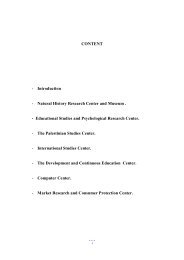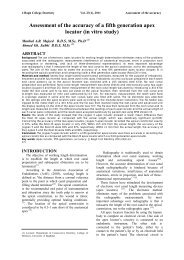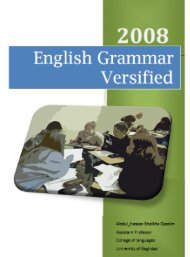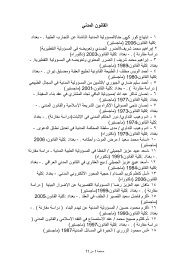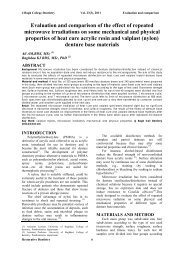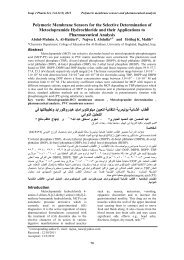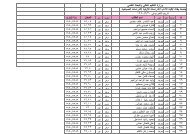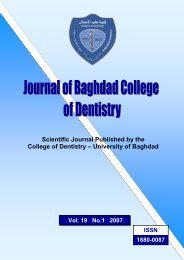Vol 21 No. 1
Vol 21 No. 1
Vol 21 No. 1
Create successful ePaper yourself
Turn your PDF publications into a flip-book with our unique Google optimized e-Paper software.
J Bagh College Dentistry <strong>Vol</strong>. <strong>21</strong>(1), 2009 Oral findings and health …<br />
Oral findings and health status among elderly Iraqi<br />
patients, (aged 65 and above)<br />
Fawaz Al-Aswad Ph.D (1)<br />
ABSTRACT<br />
Background: The study hypothesis was that elderly patients with many concomitant diseases and drugs would have<br />
different oral diseases, thus epidemiological information about their oral health is urgently needed in geriatric dental<br />
care for diagnosis treatment and prevention. The aim was to obtain base line information on the prevalence of oral<br />
problems and disease in elderly Iraqi patients.<br />
Materials & Method: The study group consisted of 83 (43 males and 40 females) elderly patients, they were examined<br />
to evaluate the oral health status.<br />
Results: From 83 patients who verbalized their complaints 72% complained of dry mouth, 42% had burning mouth<br />
syndrome and 48% had oral mucosal lesion. The commonest oral finding was denture stomatitis 30%.<br />
Conclusion: This data suggests that there was considerable unmet dental need with significant oral disease in this<br />
target group.<br />
Key words: Geriatric dentistry,.saliva. BMS (J Bagh Coll Dentistry2009; <strong>21</strong>(1):53-56)<br />
INTRODUCTION<br />
Geriatric dentistry is a branch of dentistry<br />
concerned with dental care for aging populations,<br />
the frail elderly need a special care because they<br />
suffer from extensive oral disease, have medical<br />
problems that complicate the oral health, and also<br />
because their age and state of health complicate<br />
their diagnosis and treatment (1) .<br />
In addition older patients are less likely than<br />
younger patients to report symptom complaints,<br />
and often they are completely unware of<br />
pathology that would create dramatic symptoms<br />
in younger patients, in one study of older adults,<br />
more than half of 20 potentially serious medical<br />
systems were never reported to health<br />
professional (2) .<br />
Systemic disease may directly or indirectly<br />
harm the oral cavity by altering saliva, which<br />
play an essential protective role in the mouth (3) ,<br />
or by the side effect of the medication (4) . On the<br />
other hand, a number of significant age related<br />
changes occurred, fortunately most of these<br />
normal aging changes do not cause oral disease<br />
(5,6) , instead it is the cumulative effects of both<br />
oral and systemic disease that account for the<br />
extensive pattern of oral disease among the<br />
elderly (7,8) .<br />
During the last decade several studies were<br />
done to determine the oral conditions of the older<br />
adults (9-13) . Berkey (14) , in a comprehensive<br />
review of oral health studies of elderly published<br />
between 1970 and 1989 described the<br />
compromised oral health status of nursing home<br />
residents.<br />
(1) Lecturer, department of oral diagnosis, college of dentistry,<br />
university of Baghdad.<br />
Up to 70 percent of residents had unmet oral<br />
(decay), poor oral hygiene, periodontal disease<br />
and soft tissue lesion. Another survey conducted<br />
in 1993 on 3479 elderly found that 93 percent of<br />
edentulous had oral problem and 61 percent of<br />
the dentate had oral problem also (15)<br />
Gift (16) , reported that only 15 percent of the<br />
residents of nursing home survey were described<br />
as having excellent or very good oral health,<br />
while other study reported that approximately<br />
one third of community dwelling elderly have<br />
untreated coronal or root caries and other oral<br />
health problems including periodontal disease,<br />
attrition, un replaced missing teeth, abrasion and<br />
erosion. (17) Other reports give evidence that more<br />
than 45.9% of elderly patients had one or more<br />
oral mucosal lesion (18)<br />
Therefore, the present study was conducted<br />
since no extensive studies have been made in<br />
Iraq to obtain information on the oral status<br />
conditions among elderly patients and to<br />
investigate the relationship between the finding<br />
in relation to age and gender.<br />
MATERIALS AND METHODS<br />
The sample<br />
The study sample consisted of 83 patients of<br />
both genders with age range from (65 – 80)<br />
referred to the college of dentistry, university of<br />
Baghdad, from <strong>No</strong>vember 2005 to June 2006,<br />
they were examined to detect the oral health<br />
status including the complaining of dry mouth,<br />
Burning mouth syndrome and oral mucosa<br />
lesions.<br />
The following questions have been shown to<br />
help to identify people with, or at risk of<br />
developing salivary gland hypofunction:<br />
Oral diagnosis 53



